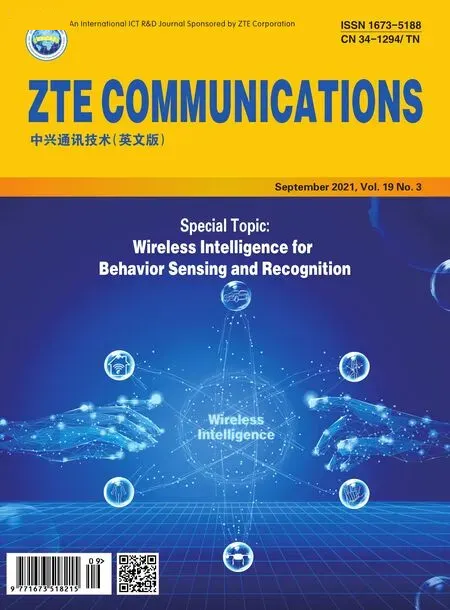Editorial:SpecialTopic on Wireless Intelligence for Behavior Sensing and Recognition
Behavior sensing and recognition is the core technology that enables a wide variety of applications,e.g.,healthcare,smart homes and public safety.Traditional approaches mainly use cameras and mobile/wearable sensors.However,all these approaches have certain disadvantages.For example,camerabased approaches have the limitations of requiring line of sight with enough lighting and breaching human privacy potentially.Mobile/wearable sensor-based approaches are inconvenient sometimes as users have to always wear certain sensorrich devices.Recently,intelligence-based wireless techniques(e.g.,Wi-Fi,ultra-wideband(UWB),mmWave,5G,acoustic and light communications)are emerging as novel approaches to behavior sensing and recognition.Compared with traditional approaches,wireless signal-based approaches have a set of advantages;for example,they do not require lighting,provide better coverage as they can operate through certain barriers,preserve user privacy,and do not require users to carry any devices as they rely on the wireless signals reflected by humans,and even animals.As a result,the recognition of quite a number of behaviors,which is difficult based on traditional approaches,has now become possible,e.g.,the recognition of fine-grained movements(such as gesture and lip language),keystrokes,drawings and gait patterns,behavior-based authentication,intrusion detection,presence monitoring,vital signals(such as breathing rate and heart rate),etc.
This special issue ofZ T E Communicat ionsprovides the opportunity for technical researchers and product developers to review and discuss the state-of-the-art and trends of wireless intelligence for behavior sensing and recognition techniques and systems.We have six invited papers covering different topics of wireless intelligence,including key techniques,applications and the literature review.
The first article,“HiddenTag:Enabling Person Identification Without Privacy Exposure”,by QIU et al.summarizes the research of person identification and introduces a novel approach without privacy exposure by leveraging acoustic and Wi-Fi channel state information(CSI)sensing.The authors utilize smartphones to identify different users via profiling indoor activities by inaudible sound.The proposed approach generates specific sound signals and acoustic features for constructing the human body signatures.The authors also use CSI sensing to trigger the system of acoustic sensing.Based upon the implemented prototype and evaluation results,this introduced approach can distinguish multiple people in 10–15 s with 95.1%accuracy and maintain 84%–90%online accuracy.
The second article,“Device-Free In-Air Gesture Recognition Based on RFID Tag Array”,by WU et al.introduces a novel system to recognize both dynamic gestures and static gestures via a device-free approach based on an RFID tag array,which can be used for human computer interaction.Particularly,the authors carefully extract the temporal-spatial feature of received signals to distinguish dynamic gestures and static gestures.Moreover,they design a convolutional neural network and Long Short-Term Memory(CNN-LSTM)combined framework to recognize the gestures by considering the temporal and spatial features together.The authors have implemented a system prototype and conducted the extensive experiments that show over 90%accuracy in the gesture recognition.
The third article,“Indoor Environment and Human Sensing via Millimeter Wave Radio:A Review”,by LIU et al.is a systemic review of mmWave sensing.The authors summarize the prior works with a focus on two typical mmWave sensing tasks:environment reconstruction and human behavior recognition.Through these works,the unique advantages of mmWave,i.e.,fine-grained sensing resolution and robust sensing for multiple co-existing objects,are highlighted.Finally,they use a table to further classify the works and discuss the potential directions for future work,which may inspire new ideas in the mmWave sensing field.
The fourth article,“Using UAV to Detect Truth for Clean Data Collection in Sensor-Cloud Systems”,by LI et al.presents the research about a flexible and convenient data collection method in sensor-cloud systems and classifies the methodologies into two categories:the mobile vehicle(MV)based and mobile edge users(MEUs)based.In view of the latter,the authors further elaborate its pros and cons.As a conclusion,the authors point out that the important issue in such applications is the security of data collection which mainly comes from the security of MEUs and sensing devices,and put forward a scheme that uses unmanned aerial vehicles to detect the truth of sensing devices and MEUs(UAV-DT)to ensure the security of the data source and transmission in the sensor-cloud systems.
The fifth article,“Artificial Intelligence Rehabilitation Evaluation and Training System for Degeneration of Joint Disease”,by LIU et al.studies the degeneration of joint disease using AI technology.To find effective,convenient and inexpensive therapies,the authors magnificently combine Traditional Chinese Medicine(Daoyin)with AI to design a rehabilitation assessment system.Several technologies are incorporated,including key-point detection,posture estimation,heart rate detection and deriving respiration from electrocardiogram(ECG)signals.The system is embedded into a portable wireless device for beneficial use in daily life.Their experiments show the effectiveness of the proposed system.
The last article,“A Survey of Intelligent Sensing Technologies in Autonomous Driving”,by SHAO et al.presents a thorough review of intelligent sensing technologies for autonomous driving.Autonomous driving is a promising technique for the future of vehicles.The authors investigate the impact of sensing technologies on car architecture shaping and explore the generic intelligent sensing algorithms in autonomous driving.They also discuss the future trends of intelligent sensing in autonomous driving,such as end-to-end policy decision models.
We are grateful to all the authors for their valuable contributions and to all the reviewers for their valuable and constructive feedback.We hope that this special issue is interesting and useful to all readers.
- ZTE Communications的其它文章
- ZTE Communications Guidelines for Authors
- Feedback-Aware Anomaly Detection Through Logs for Large-Scale Software Systems
- Semiconductor OpticalAmplifier and Gain Chip Used in Wavelength Tunable Lasers
- Super Resolution Sensing Technique for Distributed Resource Monitoring on Edge Clouds
- QoE Management for 5G New Radio
- A Survey of Intelligent Sensing Technologies in Autonomous Driving

